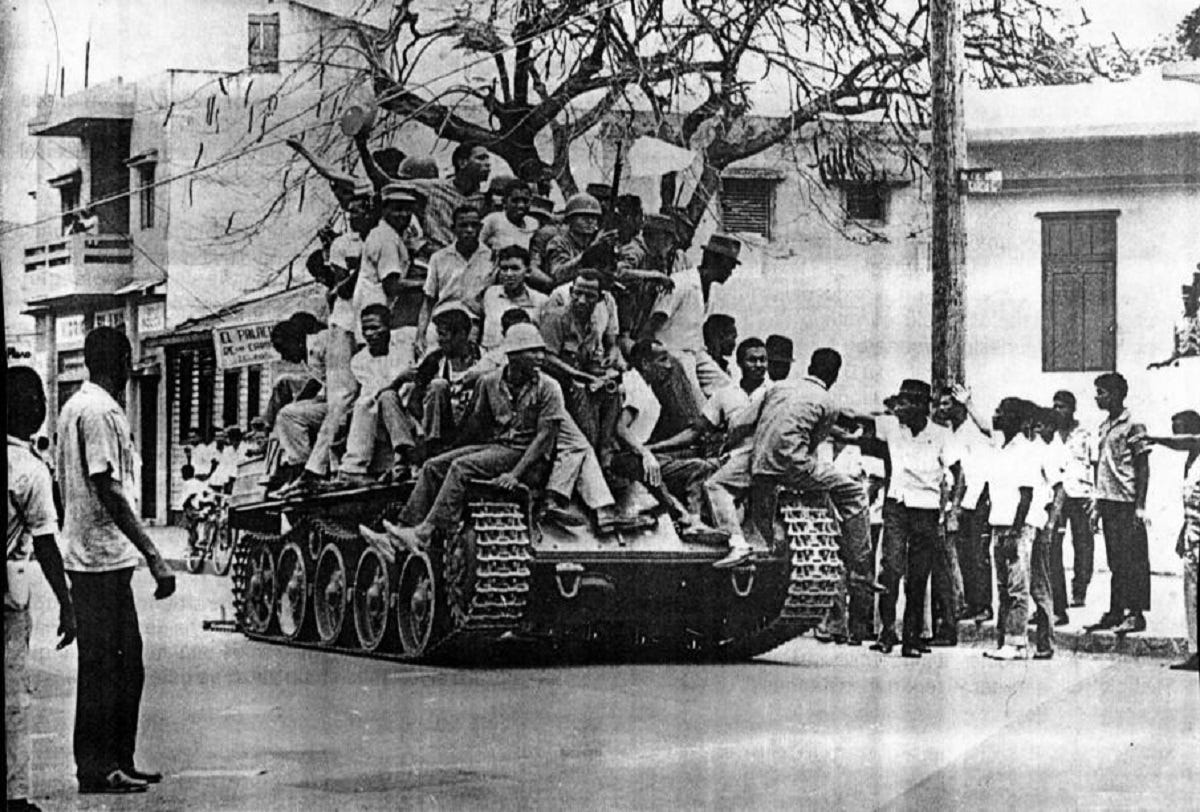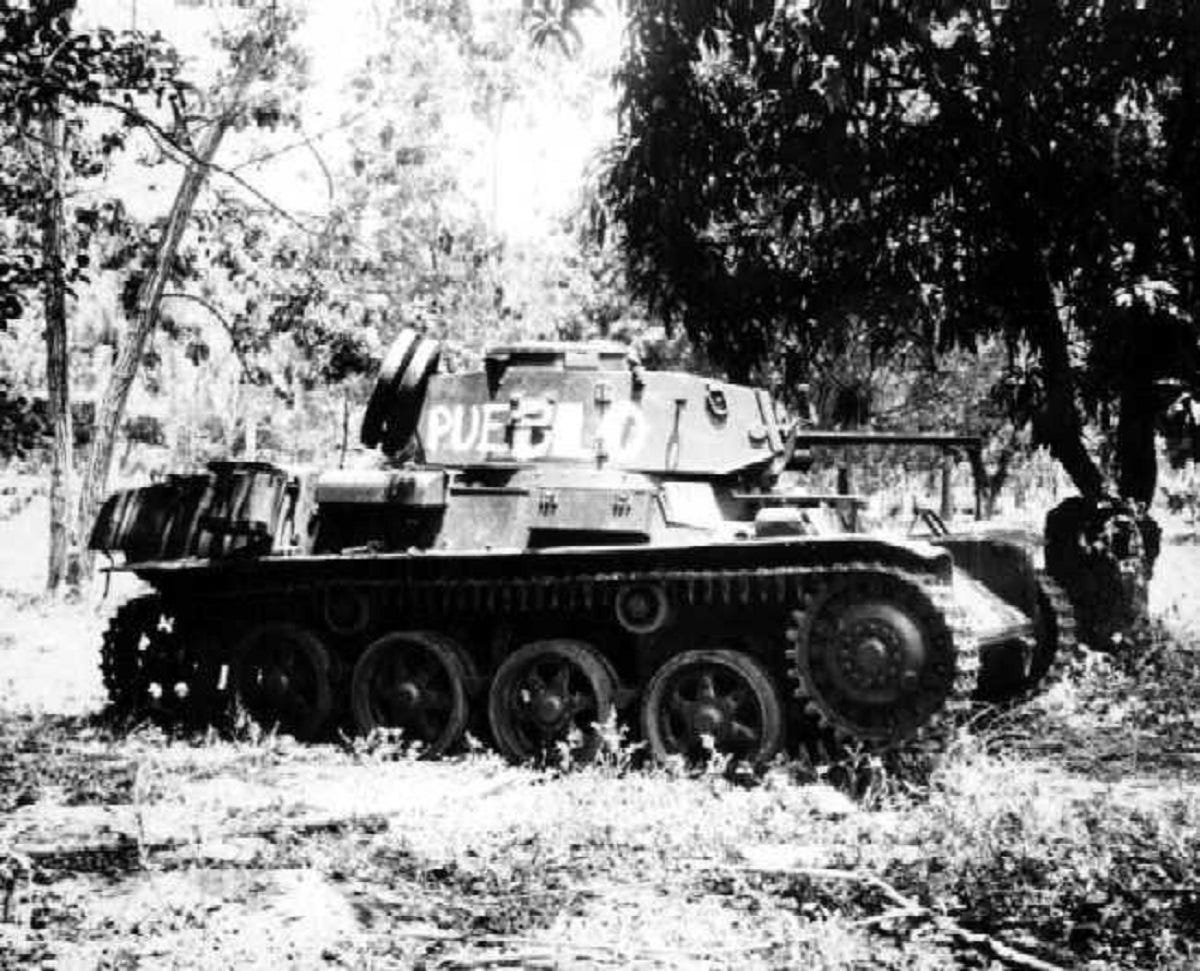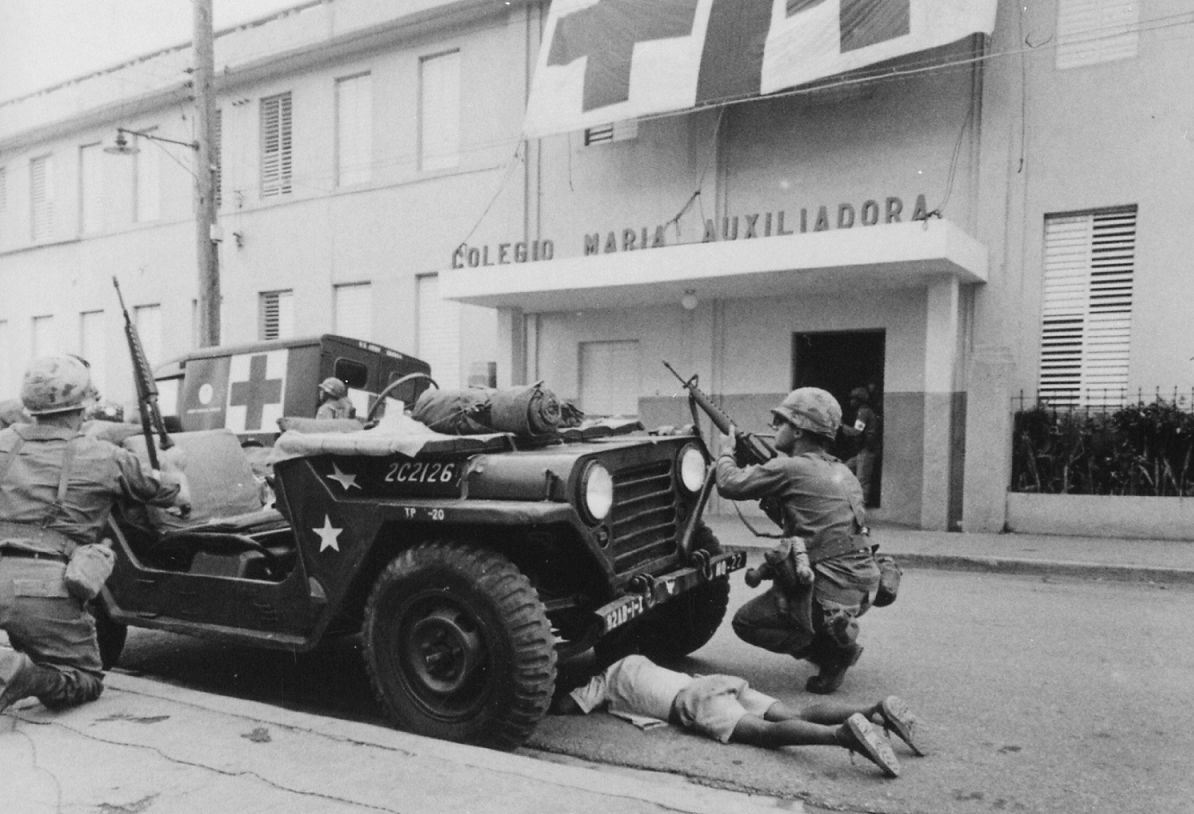The Dominican Crisis the 1965 Constitutionalist Revolt and American Intervention Review

In 1965, U.S. and Dominican Tanks Fought Brief, Trigger-happy Skirmishes
Rebel tanks were no friction match for America'southward fighting vehicles
past SEBASTIEN ROBLIN
Tanks have rarely been used in battle in the Western Hemisphere — and fights between tanks are even rarer.
Just the Dominican Republic in 1965 was ane of the exceptions, when Constitutionalist rebels fought the armored vehicles of invading U.S. Marines in the streets of the capital city, Santo Domingo.
Stranger nevertheless, the Dominicans were using Swedish tanks.

What were the Marines — and afterwards the 82nd Airborne Partition and the Brazilian army — doing in the Dominican Democracy?
Taking sides in a civil war.
The United States had a long history of intervening in the Dominican Republic, even occupying it from 1916 to 1924 and running the community agency in that location for its own profit. But after a U.S.-trained National Guardsmen, Trujillo, bullied his manner to power with "99 percent of the vote" in the 1930 elections and proceeded to rule as a sociopathic dictator, the United States largely left the nation alone.
Trujillo went on to rename the majuscule metropolis afterwards himself, established seven mutually hostile spy agencies, murdered near 50,000 Dominicans with his secret police and built up the armed forces essentially to the tune of 21 percent of national Gross domestic product.
Trujillo spent the money on an air force of 240 planes and a navy with xi warships—which he intended to menace the Dominican Democracy'south traditional rival on the other side of Hispaniola isle, Haiti.
He capped information technology off with an assassination attempt on the president of Venezuela, who had authored a disquisitional human rights report.
Trujillo's murderous habits ultimately backfired when he was assassinated in 1961 — but what followed was coup subsequently coup, as one armed services-backed individual was over thrown by another.
The sole exception was Juan Bosch, a center-left intellectual elected in Dec 1962 with a liberal agenda of promoting political liberty and social reform — and fatally, cutting military spending. The military overthrew Bosch after just seven months in office.
Starting in April 24, 1965 a pro-Bosch coup with support from a faction of younger officers in the army led past one Col. Francisco Caamaño, overthrew the widely unpopular strongman currently in power, Reid Cabral. At first, the old guard of the military machine, nether the leadership of air force general Elias Wessin y Wessin, remained neutral.
Bosch's supporters, known as the Constitutionalists, included two Communist parties inspired by the revolution in neighboring Republic of cuba, as well equally two army battalions and navy frogmen.
They distributed small-scale arms and Molotov cocktails among the revolutionaries and captured Radio Santo Domingo and the presidential palace, forcing Reid to flee. Some of them went on to settle scores with old Trujillo backers.
When the military under Wessin realized the Constitutionalists wanted to bring back Bosch, they launched an attack against the revolutionaries on Apr 25, 1965. World War II-era F-51 Mustang fighters strafed and rocketed Santo Domingo.
"Thousands" of Dominican citizens reportedly took mirrors out on the street in an effort to reverberate light into the eyes of the attacking pilots. More than effectively, a automobile gun shot one of them down.
Boxing for Duarte Bridge
American ambassador William Tapley Bennett was alarmed by the violence and disorder mounting in the streets. The United States began organizing the evacuation of its citizens. One group of rebels broke into the Hotel Embajador where evacuees were gathered and threatened them with bullets shot over their heads.
Bennett argued the United States should intervene against the Constitutionalists, claiming they were infiltrated past Cuban Communists — even though Bosch was a moderate, not a Communist. Bosch himself never returned from exile during the fighting.
Pres. Lyndon Johnson was reluctant — he was hoping the Loyalists would take care of the rebels. Since the Roosevelt administration, the The states had refrained from open armed forces intervention in Latin America — though anti-Communist covert operations using proxies, such as in Guatemala and the Bay of Pigs landing in Cuba, were some other matter.
The ambassador held a meeting expected to finish of hostilities between the Loyalists and the Constitutionalists on April 27, 1965. But Bennett was reportedly so condescending towards the Constitutionalist leaders that they changed their minds and decided to keep on fighting.
The aforementioned day, Wessin'due south i,800 Loyalist troops launched an attack into the middle of Santo Domingo, including the army'southward prized tank brigade based almost San Isidro air base.
This included 12 French AMX-13 light tanks — fast moving, with decent firepower only thin armor — as well as 24 Stridsvagn L-60 light tanks, and 13 Landsverk Lynx armored cars — both vehicles types made in Sweden.
Before they became famous for exercise-it-yourself furniture, the peaceful Swedes were major weapons-manufacturers. The early Stridsvagn 50-60 tanks were considered first-class designs for their advanced suspension systems — in the 1930s. The L-sixty's 24 millimeters of armor and small 37-millimeter cannon were both obsolete past the middle of Earth War II.

The Hungarians used their own version of the 50-threescore, the Toldi tank, in World State of war II. Information technology performed well as long equally it didn't see enemy tanks or anti-tank weapons — which were everywhere on the Eastern Front.
But the Dominican tanks were intended to fight Haiti, not the Soviet regular army.
As the Loyalist armor seized a bridgehead on the western side of the Duarte Bridge, they outran their supporting infantry. Constitutionalist supporters, realizing they could approach the unescorted tanks without being spotted, began tossing Molotov cocktails into the armored columns and unleashed a hail of fire from rifles, machine guns and mortars they had looted.
The Loyalist attack stalled and and so began to route. Several Fifty-60 and AMX-13 tanks were abased and put into use by the Constitutionalists.
On April 28, 1965, Pres. Johnson deployed a battalion from the sixth Marine Expeditionary Brigade, embarked at body of water, to safeguard the evacuation of U.S. citizens. The Marines landed past helicopter and shortly established a perimeter effectually the embassy. U.S. Navy ships then brought in LVT amphibious personal carriers, Ontos anti-tank vehicles, and heavy Thousand-48 Patton tanks.
A sniper killed a Marine virtually the U.S. embassy, and in the ensuing crossfire a grenade mortally wounded a Dominican girl. The U.S. denizen evacuation wrapped upwards without further loss of life.
Meanwhile Santo Domingo had descended into violence, anarchy and annexation. Rogue insubordinate groups captured the Villa Consuelo police force headquarters and executed the survivors. Someone freed 700 prisoners from the Fortress Ozama prison. The Red Cross estimated at that place were already one,500 to 2,000 dead.

The American intervention
By April 29, 1965, the Loyalists forces were close to crumbling. Administrator Bennett urged Pres. Johnson to intervene unilaterally in the civil state of war, arguing that a liberal regime nether Bosch would likely requite way to "Castroism" if events were immune to run their course.
Johnson agreed, and initiated Functioning Power Pack. The side by side 24-hour interval, the 82nd Airborne Partition began airlifting into San Isidro Airbase, along with the remaining 2 battalions of the sixth Marine Brigade. At its top, this would bring U.S. forces in the Dominican Commonwealth upward to 21,900 men.
Farcically, the Us was ostensibly to remain neutral and impose a ceasefire, which it was to accomplish by advancing its forces into Constitutionalist territory in Santo Domingo in order to secure the Loyalist lines.
Marines and paratroopers exchanged fire with the Constitutionalists in intense firm-to-house fighting. I Marine unit of measurement was pinned downwards and received permission to use back up weapons, They pounded the rebel positions with more than xxx rockets from their M20 Super Bazookas.
Both the Marines and paratroopers successfully advanced to their designated objectives — only to observe that the Loyalist units they were meant to support had pulled out, leaving a gap between their lines. Another plush battle closed the gap between the ii forces.
During these pitched engagements, Marine armor engaged captured tanks several times.
The nearly-thinly documented incident is a reported exchange of burn between a massively outgunned L-60 and a Marine Patton tank. The viii-ton L-threescore, armed with a 37-millimeter gun, could hardly have dented the armor of the 50-ton Patton. The same cannot be said for the Patton's 90-millimeter cannon, which "disintegrated" the smaller vehicle.
Another L-60 was knocked out past a Marine M-50 Ontos anti-tank vehicle. These unique vehicles bristled with half dozen heavy 106-millimeter recoilless rifles —each had to exist individually reloaded subsequently taking a shot.
The Ontos was definitely a "shoot-and-scoot" vehicle — it was and then thinly armored that an L-60 might actually take damaged one. An Ontos is likewise credited with blowing the turret off a rebel AMX-13.
This was the showtime combat employment for both the Ontos and Thou-48 — they went on to see extensive use in Vietnam — and the only time the Ontos was used in the role it was designed for, fighting enemy tanks.
American infantry too turned one of their M40 recoilless rifles on a rebel gunboat that was shelling them, sinking the 350-pes ship. The possessor later on sued.

Battling the Brazilian ground forces
Once the Regular army and Marines airtight the gap, the Constitutionalist forces were isolated from each other on either side of Santo Domingo — and the U.S. military machine wouldn't allow the two warring factions to cross the line.
The Americans therefore were able to impose a ceasefire on the 2 parties by May 5, 1965 and arrange for a new civil-military junta to dominion the country.
Neither faction was happy with the ceasefire and small-scale-calibration skirmishes and sniper burn down continued. The Loyalists even launched an air attack that hit U.S. troops by blow — the Americans' return burn shot down some other F-51.
Only overall, the fighting died down — and the Marines withdrew in early June, while the Ground forces remained behind to perform peacekeeping and stability operations including large-scale nutrient handouts.
The unilateral U.S. intervention in the Dominican Republic's affairs was widely criticized, both in the American press and throughout Latin America. In an effort to garner back up, the Usa organized an Inter American Peace Force through the Organization of American States to take command of the mission.
It included the 82nd Airborne Division, a battalion of Brazilian troops and a company each from Paraguay, Nicaragua and Republic of honduras. The force came under the command of Brazilian general Hugo Panasco Alvim.
Equally the Constitutionalist saw their influence sidelined in favor of a new conditional government junta, they launched a coordinated set on on June fifteen, 1965, hitting the defensive positions of both the Brazilian army and the 82nd Airborne with mortars, motorcar guns and tanks.
The attack was a disaster for the Constitutionalists, who lost 67 killed. Twenty-4 U.S. and 5 Brazilian soldiers were wounded. The 82nd Airborne counterattacked, capturing 56 street blocks and forcing the rebels dorsum to the negotiating table.
The 82nd is recorded as having knocked out a third Fifty-60 tank with a 106-millimeter M40 recoilless rifle. Information technology seems likely it was during this date.
But ane more major clash occurred, involving non tanks but rather a funeral procession led by Col. Caamaño mourning the Constitutionalists dead. While the procession breakfasted at the Hotel Matum in Santiago, 300 Loyalist troops attacked. Fighting raged for five hours, killing 15, until U.South. troops brought in by helicopter negotiated a ceasefire.
Tanks were involved in ane more incident at the cease of the war. The Loyalist leader Wessin was to be eased out of power to allow the new junta to rule. Merely on the pretext of giving a farewell spoken communication to his troops, he instead led the armored brigade in a march on Santo Domingo.
A battalion of U.S. vehicles moved to block Wessin on the highway, and he afterwards fled into exile at the Dominican consulate in Florida "at the point of American bayonets."
Every bit many as 4,000 Dominicans died in the Dominican civil war. Ix U.South. Marines and 18 U.Southward. Ground forces soldiers also died. The United States withdrew its last troops in 1966.
Constitutionalist leader Col. Caamaño moved to London to serve as a military attaché. He afterwards returned to the Dominican Republican to lead an insurgency. He was captured in boxing and summarily executed.
The conservative Joaquin Balaguer was elected president in 1966 — merely the Dominican Republic wouldn't experience its first peaceful transfer of power until 1978. Poverty and abuse would lead many Dominicans to immigrate to the United States, including Nobel-prize winning writer Junot Diaz.
During the U.S. occupation of the Dominican Republic, the U.S. Regular army refurbished 12 of the Dominican ground forces'south surviving L-sixty tanks and put them dorsum into service. The antiquated tanks remained active until 2002.

whiteleggehopearabits.blogspot.com
Source: https://medium.com/war-is-boring/in-1965-u-s-and-dominican-tanks-fought-brief-violent-skirmishes-f206040e66b3
0 Response to "The Dominican Crisis the 1965 Constitutionalist Revolt and American Intervention Review"
Post a Comment